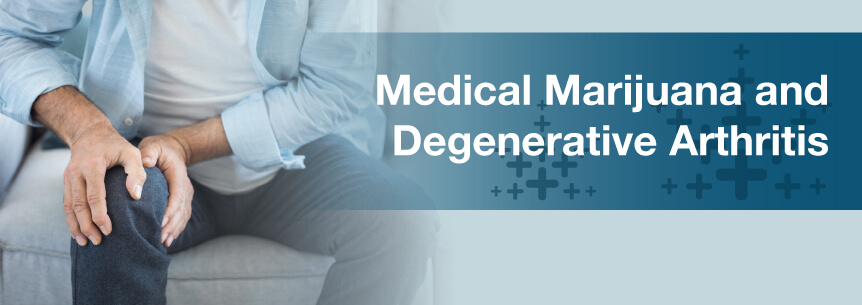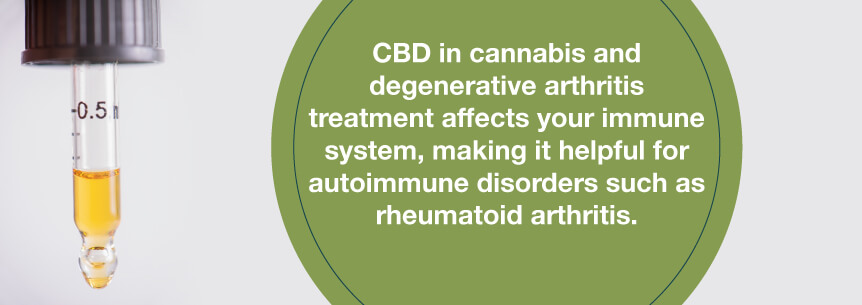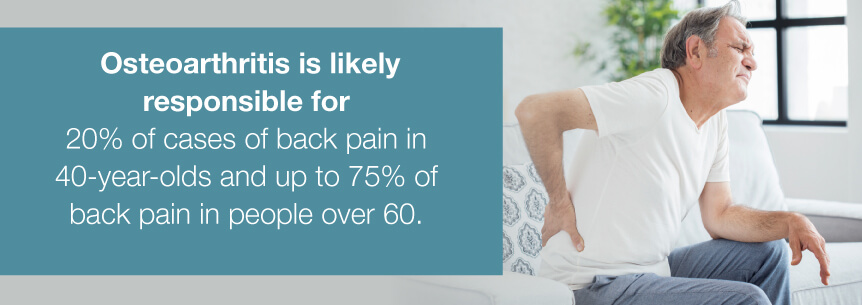
The Arthritis Foundation tells us more than 100 types of arthritis exist. One form, degenerative arthritis, also known as osteoarthritis or OA, is the most common. About 30 million people have osteoarthritis in the U.S., but almost everyone is affected by the age of 60, according to the Arthritis Foundation. This condition can be painful and lead to disability as it progresses. Treatment methods, including medical marijuana and degenerative arthritis, can help with the pain and inflammation of the progressive disease.
Lately, there’s been increasing research showing that medical marijuana for degenerative arthritis is effective in treating the inflammation, fatigue and pain the disease causes.
Millions of Americans suffer from arthritis and, according to the CDC, almost 60 million people, or about 20 percent of the population, will have arthritis by 2020. The 100+ different types of arthritis, which include degenerative arthritis (AKA osteoarthritis), make arthritis one of the most common chronic illnesses in the United States, according to the National Academy on an Aging Society.
Arthritis costs Americans billions of dollars in medical bills and lost wages. According to a Stanford University study titled “The economic impact of arthritis,” patients with arthritis are projected to incur over $56 billion in medical expenditures and work loss.
Currently, doctors use more than 100 medications and drugs to treat arthritis. But many patients who suffer from degenerative arthritis have opted instead to use medical marijuana, which is an affordable, natural alternative with mild side effects.
Find A Doctor Find A Dispensary

Recent research has shown medicinal marijuana can be an effective alternative arthritis treatment. Weed is a potent analgesic (pain reliever). Studies have also demonstrated that cannabis suppresses inflammation — which is the core symptom of arthritis.
While the herb is effective at treating a whole range of symptoms, marijuana for degenerative arthritis is highly effective for treating the following arthritis-specific symptoms.
THC and CBD are two of cannabis’s active compounds. They can work wonders for individuals struggling with debilitating joint pain. Medical marijuana:
While THC is the psychoactive compound causing the high you get with recreational weed, the CBD in medical cannabis for degenerative arthritis will provide you with pain relief without producing the mental effects.
Osteoarthritis pain may be neuropathic or nociceptive. The cannabinoids in marijuana and degenerative arthritis treatment interact with your endocannabinoid system’s CB1 and CB2 receptors, which regulate releasing of immune cells in the central nervous system and neurotransmitters for managing both neuropathic and nociceptive pain levels.
In fact, when the CB1 receptor was activated in rats’ osteoarthritic knee joints, it reduced pain sensitivity, according to a study published in the journal Arthritis and Rheumatism.
Another study published by PLoS One using animals found CB2 receptor activation reduced osteoarthritis-related pain and inflammation.
CBD in cannabis and degenerative arthritis treatment affects your immune system, making it helpful for autoimmune disorders such as rheumatoid arthritis. The journal Rheumatology published a study showing high levels of CB2 receptors in arthritis patients’ joint tissue. Using medical pot fights joint inflammation by activating CB2 receptor pathways, according to the study.

Other studies suggest marijuana and its cannabinoids help modulate bone maintenance and growth by activating the body’s CB1 and CB2 receptors — much like in the animal studies. The cannabinoids in marijuana and degenerative arthritis treatment enhance bone formation and restrain bone resorption, which manages proper bone formation.
THC is an analgesic (relieves pain) and anti-inflammatory. However, it’s also found to reduce depression and anxiety that often come with diseases, particularly those that cause loss of mobility and pain, like rheumatoid arthritis.
It’s a good idea to sample different strain types until you find the best ones for your symptoms. Indicas, sativas and hybrids all have their weaknesses and strengths. By sampling various strains, you’ll discover what works. For instance, strains high in CBD content tend to produce a relaxing, calming effect, which patients suffering from painful joints and sore muscles find to be a blessing.
You can start with these strains:
As you experiment, you’ll eventually find the strains you like the most and that are most effective.
You’ll find CBD readily available for smoking, vaping, applying on your skin topically or using in a tincture. Here are some tips:
Today, arthritis is approved as a qualifying condition for medical marijuana in more than a handful of states, and the list is expected to grow. During these times, when opiate abuse is quickly reaching epidemic proportions, medical marijuana treatment is a far less addictive and harmful alternative for treating your arthritis pain and inflammation.
We can get you the help you need here at Marijuana Doctors. We’ll help you find a marijuana doctor and provide you with a comprehensive list of cannabis dispensaries where you can purchase your cannabis products.
Find A Doctor Find A Dispensary
Degenerative arthritis is a chronic disease damaging the tissues and cartilage in joints. This type of arthritis is also known as degenerative joint disease. Normal joints have cartilage over the ends of the bones to provide a smooth surface for joint movement. With osteoarthritis, the cartilage has broken down, which leads to swelling, pain and difficulty moving the affected joints. As the disease progresses, it can cause the bones themselves to break down and develop spurs, worsening the pain and disability.
Osteoarthritis is a natural part of aging. As we age, the normal amount of water in the cartilage increases while the protein in the cartilage breaks down. Repetitive but unavoidable use of the joints, called wear and tear, also damages the cartilage over time. This process also results in swelling and pain. Over time, the cartilage flakes or cracks.
In some people, osteoarthritis has a genetic component. A rare form of the disease occurs due to a defect in how the body produces collagen, which makes up joint cartilage.
Osteoarthritis can also be secondary, which means another condition causes it. Obesity, repeated trauma, gout, rheumatoid arthritis (RA) and diabetes can all cause OA in different ways. Obesity, for example, causes degenerative arthritis by increasing stress on the cartilage.
There are several types of OA, determined based on on the joints affected. The following are the five most common forms of OA:

The hallmarks of degenerative arthritis are stiffness, swelling and pain in affected joints. This pain is usually worse in the morning and after inactivity. For most people, the pain starts in one or two joints, especially weight-bearing joints in the feet, knees and hips. Symptoms can eventually spread to the lower back, neck, fingers and other joints. Patients with degenerative arthritis may hear clicking or cracking sounds when they move their affected joints. You may also experience a reduced range of movement with osteoarthritis.
William Heberden first described the symptoms and hallmarks of what is now known as degenerative arthritis in the 18th century. Heberden explained that the bony swellings on the hands were a result of OA. He developed an explanation for the bumps, which are now called Heberden’s nodes, stating that they occur in the fingers as the cartilage softens or wears away.
It wasn’t until 1940 that the first joint replacement surgery took place, when Dr. Austin Moore performed a metallic hip replacement surgery on a patient with degenerative arthritis. While methods and materials have changed, hip arthroplasty remains the standard for severe hip OA.
Osteoarthritis can lead to progressive and chronic sharp or dull pain. As osteoarthritis progresses, bone growths enlarge the joints and increase pain. This process will also reduce mobility and joint function. Many people with advanced OA have difficulty performing basic tasks and become unable to work. In severe cases, osteoarthritis can require joint replacement, which is most common with OA of the knee or hip.
Along with the physical effects of OA, the disease can also impact quality of life. People with osteoarthritis may suffer from depression, anxiety and social withdrawal as they are unable to do the things they once enjoyed.
Today, we have an abundant supply of statistics relating to degenerative arthritis:

Pain and swelling associated with degenerative arthritis are usually treated with one or more of the following three medications:
If conservative treatment is ineffective, your physician may recommend cortisone injections to relieve pain in the affected joint. Because cortisone can worsen joint damage when it’s overused, it’s usually limited to three or four injections per year, according to the Mayo Clinic.
Joint replacement is reserved for severe OA when the cartilage is completely worn or absent. This surgery, called arthroplasty, involves removing the damaged joint surfaces and replacing them with a prosthetic device. Knee and hip replacements are the most common, but surgeons replace other joints including those in the elbow, wrist, ankle and shoulder.
Researchers have discovered many exciting developments in the treatment and prevention of OA in recent years.
One study, published in 2012, found OA patients who took a single zoledronic acid infusion reported improved pain scores. MRI scans even showed a reduction in the size of lesions on the patients’ bone marrow.
Researchers at the University of Southern California’s Keck School of Medicine have also created a molecule that may treat arthritis in the future. When injected into an arthritic joint, the molecule may render arthroplasty unneeded by triggering cartilage regeneration.
Finally, a new treatment was recently approved by the FDA to treat people with moderate to severe OA who are not candidates for arthroplasty. This treatment, which is called cooled radiofrequency ablation or Coolief, effectively eases pain by using radio frequency to mute nerves sending pain signals to the brain.